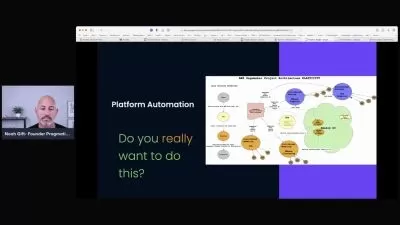ML for Business professionals using No-Code AI tools
Analytics Vidhya
4:49:19
Description
Master data-driven decisions in business with No-Code AI. Explore Tableau, ML, Deep Learning & ChatGPT for insights.
What You'll Learn?
- Understand the critical role of data in modern business and the importance of data-driven decision-making
- Empower yourself to make data-driven decisions independently with no code tools like Tableau and Orange Data Mining
- Master fundamental statistical measures like Mean, Median, and Standard Deviation for decision-making
- Differentiate between various decision-making approaches and their pros and cons
- Recognize common biases in decision-making through real-world examples
- Understand Confidence Intervals and sample bias with practical illustrations
- Gain hands-on experience in data preparation using drag-and-drop tools like Tableau Public and Orange
- Evaluate reports, charts, and visualizations to uncover insights
- Understand different types of Machine Learning problems, algorithms, and evaluation metrics
- Explore the power of No-Code AI tools with Tableau and Orange, to build and assess machine learning models without coding
- Create ML models (Classification, Regression, and Unsupervised) using Orange without a single line of coding
- Gain expertise in various machine learning algorithms, including KNN, Decision Trees, Random Forest, Logistic Regression, K-Means, and Hierarchical Clustering
- Learn to identify important features and best practices for creating high-quality ML models
- Dive into Deep Learning and its applications in business problem-solving
- Explore optional topics, including using Machine Learning for Images and Text Data with No-Code tools
- Stay up-to-date with the latest trends in Generative AI tools including ChatGPT for text-generation, and Image Generation using DALL-E
- Explore the ethical considerations surrounding AI and Machine Learning
Who is this for?
What You Need to Know?
More details
DescriptionData being the backbone of all businesses and organizations in the world today makes interacting with data even more critical to gain insights and make informed decisions. Most business teams rely on the data analytics or insights team to interpret data and generate insights, which can lead to inefficiency within the organization.
Earlier businesses used to have limited data, and all this data could have been analyzed by the limited people in the insights team of the company with immense technical knowledge. But now the landscape has changed drastically!!! it has come to a point where even non-technical roles require analysis of some form of data to make their decisions. And that is where the problem comes in. People in roles like - marketing, HR, operations, sales, etc., have less or less technical knowledge. These people rely on the insight team for even the smallest insights. This leads to inefficiencies in the process and a lot of loss to the company.
And this is precisely where no-code tools come in. No-code tools like Orange Data Mining and Tableau have revolutionized how businesses handle data analytics and visualization. These platforms democratize data science by making it accessible to individuals who may not have programming skills, thereby widening the pool of talent capable of deriving insights from data. With user-friendly drag-and-drop interfaces, employees can quickly and easily set up data workflows, conduct complex analyses, and generate visual reports. This speed and agility are crucial for making timely, data-driven decisions in a fast-paced business environment. Moreover, the ease of use encourages cross-functional collaboration, allowing team members from diverse departments to contribute their expertise to data projects. As a result, businesses can enjoy a more holistic understanding of their operations, customer behavior, and market trends without investing in extensive training or specialized personnel. Furthermore, these no-code tools offer a cost-effective solution by reducing the need for a large team of data scientists and developers while minimizing long-term maintenance costs. Platforms like Orange and Tableau empower organizations to be more data-driven, agile, and innovative.
Our No-Code AI course empowers business professionals to make data-driven decisions independently without relying on the data team. This course will enable you to make better business decisions by applying fundamental statistical metrics and prediction methods using various drag-and-drop tools. You will learn to analyze data, generate insights, and build machine-learning models without writing a single line of code!
This one-of-a-kind course is structured to ensure you are up-to-date with the latest advancements in the field of no-code AI. Our no-code course spans over 5 sections and 2 no-code AI tools. Let’s have a look at the sections.
Section 1: Art of Making Decisions with Data
Gain the ability to use statistical measures such as Mean/Medium/Stddev in making decisions based on the data.
An exercise at the beginning and end of the section to show you the difference between knowledge.
Different approaches to making decisions, along with their pros and cons.
Common biases in decision-making through examples.
Understand Confidence Interval and Sample Bias
A case study to make decisions based on Data
Section 2: Powering your decisions with Charts (Tableau Public)
Present reports and evaluate information presented in reports
Showcasing scenarios where making charts can give better insights, such as identifying stock trends, Regional Patterns of Sales in a color-coded map, the relation between two features (etc.)
Introduction to Tableau using a case study.
Asking questions that require the use of different kinds of charts to answer them
Joins in Tableau
Summary of different types of charts and where to use each one of them.
Exercise at the end of the section to strengthen your concepts.
Section 3: Making Predictions for Future Readiness
Identify the type of machine learning problems
Understand why we make predictions and what are some simple methods explained using a case study that will talk about simple predictions based on average, rule-based predictions, predictions using machine learning, etc.
Best Practices to evaluate predictions and introduce concepts around evaluation metrics, train-test sets, benchmarks, etc
Understand Machine Learning and its applications
Checklist to go through if Machine Learning would be a good choice
Section 4: Introduction to a No-Code tool (Orange) using a case study
Make predictions by building machine learning models on a no-code tool - Orange Data Mining.
Assess the quality of predictions and approach of ML models created by others/team members using Orange.
Go through multiple case studies to get familiar with Orange. Each case study would start with a problem statement and data, and the participants would have to identify the target variable, features to skip, select features, and kind of problem (Classification, Regression, Clustering) When to use Deep Learning.
Demo of K-Nearest Neighbors, Decision Tree, Random Forest, Logistic Regression, K-Means, Hierarchical Clustering, etc in Orange
Best practices to create good Machine Learning models
Discussion on Model Deployment and rate of predictions
Section 5: Deep Learning and Ethics in AI
Create Deep Learning models using a no-code tool - Orange Data Mining.
Create a Deep Learning model for Text Data using Orange.
Create a Deep Learning model for Image Data using Orange.
Understand how deep learning stems as the basic building block for Generative AI.
Get familiar with Generative AI tools such as ChatGPT and DALL-E to quickly generate text and images and get ahead of the curve.
Understand the ethical concerns related to AI and how it has become even more relevant with the advent of Generative AI.
By the end of this course, you'll have a deep understanding of essential statistical metrics and predictive methods and the confidence to apply them effectively without writing a single line of code. Embrace this opportunity to become a data-savvy decision-maker, and let our course be your guide in this transformative process.
Your journey toward data-driven excellence starts here, and we can't wait to see the positive impact you'll make with your newfound knowledge and skills. We understand that the path to data-driven excellence can be daunting, filled with complex algorithms, massive datasets, and intricate visualizations. But fear not because you're not alone on this journey. With the right tools and guidance, you'll soon realize that data is not an obstacle but an invaluable asset waiting to be unlocked.
As you embark on this transformative path, remember that every data point you analyze, create a chart, and gain insight contribute to a broader understanding of your organization's goals and challenges. Your newfound skills will make you an asset to your team and position you as a catalyst for organizational change.
So whether you're a beginner just getting your feet wet or a seasoned professional looking to refine your skills, embrace the journey ahead. The road to data-driven excellence is a marathon, not a sprint. But every step you take is a stride towards a more informed, effective, and impactful future. We're excited to support you every step of the way.
Don't wait – enroll now and unleash the power of No-Code AI for your career.
Who this course is for:
- Professionals using data to make decisions
- Professionals who presenting reports / data on performance
- Professionals involved in evaluating projects and tasks
- Any student about to enter the job market, looking for a competitive edge for making decisions
- Any individual looking to add value to their business using No-Code AI
- Any individual not comfortable with coding but interested in leveraging Machine Learning and AI
Data being the backbone of all businesses and organizations in the world today makes interacting with data even more critical to gain insights and make informed decisions. Most business teams rely on the data analytics or insights team to interpret data and generate insights, which can lead to inefficiency within the organization.
Earlier businesses used to have limited data, and all this data could have been analyzed by the limited people in the insights team of the company with immense technical knowledge. But now the landscape has changed drastically!!! it has come to a point where even non-technical roles require analysis of some form of data to make their decisions. And that is where the problem comes in. People in roles like - marketing, HR, operations, sales, etc., have less or less technical knowledge. These people rely on the insight team for even the smallest insights. This leads to inefficiencies in the process and a lot of loss to the company.
And this is precisely where no-code tools come in. No-code tools like Orange Data Mining and Tableau have revolutionized how businesses handle data analytics and visualization. These platforms democratize data science by making it accessible to individuals who may not have programming skills, thereby widening the pool of talent capable of deriving insights from data. With user-friendly drag-and-drop interfaces, employees can quickly and easily set up data workflows, conduct complex analyses, and generate visual reports. This speed and agility are crucial for making timely, data-driven decisions in a fast-paced business environment. Moreover, the ease of use encourages cross-functional collaboration, allowing team members from diverse departments to contribute their expertise to data projects. As a result, businesses can enjoy a more holistic understanding of their operations, customer behavior, and market trends without investing in extensive training or specialized personnel. Furthermore, these no-code tools offer a cost-effective solution by reducing the need for a large team of data scientists and developers while minimizing long-term maintenance costs. Platforms like Orange and Tableau empower organizations to be more data-driven, agile, and innovative.
Our No-Code AI course empowers business professionals to make data-driven decisions independently without relying on the data team. This course will enable you to make better business decisions by applying fundamental statistical metrics and prediction methods using various drag-and-drop tools. You will learn to analyze data, generate insights, and build machine-learning models without writing a single line of code!
This one-of-a-kind course is structured to ensure you are up-to-date with the latest advancements in the field of no-code AI. Our no-code course spans over 5 sections and 2 no-code AI tools. Let’s have a look at the sections.
Section 1: Art of Making Decisions with Data
Gain the ability to use statistical measures such as Mean/Medium/Stddev in making decisions based on the data.
An exercise at the beginning and end of the section to show you the difference between knowledge.
Different approaches to making decisions, along with their pros and cons.
Common biases in decision-making through examples.
Understand Confidence Interval and Sample Bias
A case study to make decisions based on Data
Section 2: Powering your decisions with Charts (Tableau Public)
Present reports and evaluate information presented in reports
Showcasing scenarios where making charts can give better insights, such as identifying stock trends, Regional Patterns of Sales in a color-coded map, the relation between two features (etc.)
Introduction to Tableau using a case study.
Asking questions that require the use of different kinds of charts to answer them
Joins in Tableau
Summary of different types of charts and where to use each one of them.
Exercise at the end of the section to strengthen your concepts.
Section 3: Making Predictions for Future Readiness
Identify the type of machine learning problems
Understand why we make predictions and what are some simple methods explained using a case study that will talk about simple predictions based on average, rule-based predictions, predictions using machine learning, etc.
Best Practices to evaluate predictions and introduce concepts around evaluation metrics, train-test sets, benchmarks, etc
Understand Machine Learning and its applications
Checklist to go through if Machine Learning would be a good choice
Section 4: Introduction to a No-Code tool (Orange) using a case study
Make predictions by building machine learning models on a no-code tool - Orange Data Mining.
Assess the quality of predictions and approach of ML models created by others/team members using Orange.
Go through multiple case studies to get familiar with Orange. Each case study would start with a problem statement and data, and the participants would have to identify the target variable, features to skip, select features, and kind of problem (Classification, Regression, Clustering) When to use Deep Learning.
Demo of K-Nearest Neighbors, Decision Tree, Random Forest, Logistic Regression, K-Means, Hierarchical Clustering, etc in Orange
Best practices to create good Machine Learning models
Discussion on Model Deployment and rate of predictions
Section 5: Deep Learning and Ethics in AI
Create Deep Learning models using a no-code tool - Orange Data Mining.
Create a Deep Learning model for Text Data using Orange.
Create a Deep Learning model for Image Data using Orange.
Understand how deep learning stems as the basic building block for Generative AI.
Get familiar with Generative AI tools such as ChatGPT and DALL-E to quickly generate text and images and get ahead of the curve.
Understand the ethical concerns related to AI and how it has become even more relevant with the advent of Generative AI.
By the end of this course, you'll have a deep understanding of essential statistical metrics and predictive methods and the confidence to apply them effectively without writing a single line of code. Embrace this opportunity to become a data-savvy decision-maker, and let our course be your guide in this transformative process.
Your journey toward data-driven excellence starts here, and we can't wait to see the positive impact you'll make with your newfound knowledge and skills. We understand that the path to data-driven excellence can be daunting, filled with complex algorithms, massive datasets, and intricate visualizations. But fear not because you're not alone on this journey. With the right tools and guidance, you'll soon realize that data is not an obstacle but an invaluable asset waiting to be unlocked.
As you embark on this transformative path, remember that every data point you analyze, create a chart, and gain insight contribute to a broader understanding of your organization's goals and challenges. Your newfound skills will make you an asset to your team and position you as a catalyst for organizational change.
So whether you're a beginner just getting your feet wet or a seasoned professional looking to refine your skills, embrace the journey ahead. The road to data-driven excellence is a marathon, not a sprint. But every step you take is a stride towards a more informed, effective, and impactful future. We're excited to support you every step of the way.
Don't wait – enroll now and unleash the power of No-Code AI for your career.
Who this course is for:
- Professionals using data to make decisions
- Professionals who presenting reports / data on performance
- Professionals involved in evaluating projects and tasks
- Any student about to enter the job market, looking for a competitive edge for making decisions
- Any individual looking to add value to their business using No-Code AI
- Any individual not comfortable with coding but interested in leveraging Machine Learning and AI
User Reviews
Rating
Analytics Vidhya
Instructor's Courses
Udemy
View courses Udemy- language english
- Training sessions 45
- duration 4:49:19
- Release Date 2023/11/21









![Master Regression and Feedforward Networks [2024]](https://traininghub.ir/image/course_pic/38375-x225.webp)






